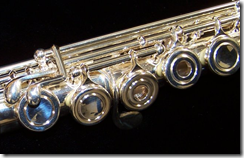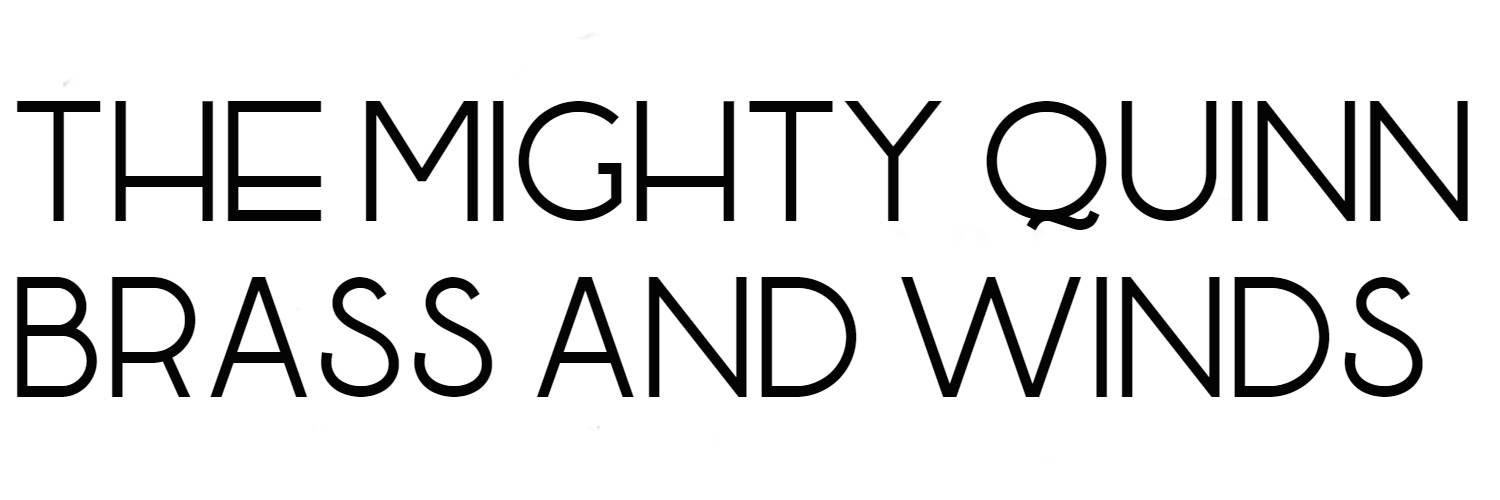The Great Flute Debate: Open or Closed Hole View
Gordon Palmer, a friend of mine posted this gem on the Sax on the Website. I wanted to put it here for my many sax friends who, like me, struggle with doubling on the flute. When I plugged my flute key holes, my wife asked me why. So I had her play her flute, the exact make and model as mine, and then she tried mine with the plugs in. My wife, the purist, heard the difference and got the keyworks plugs for her flute—it just made too much sense. Here is a picture of my plugged hole Gemeinhardt flute.

So before we wade into the great open holed flute debate, let me also say that purchasing a custom head done by craftsman Chris McKenna was the best thing I have done to date for my flute playing. All of a sudden the clarion range spoke for me. Now let’s hear from Gordon:
Many reasons are touted for having open holed key works but for perhaps 95% of players they serve no purpose and have significant detractors. Some issues are:
1. Intonation: A flute goes quite sharp when it is played loudly. This can be compensated for (for SOME notes) by partly closing a tone hole. This is possible only with open holes. Alternatively, the pitch can be humoured with special fingerings when playing very softly. However an accomplished player has sufficient versatility in embouchure and air pressure to correct the intonation by other means. Certain alternative fingerings are available to humour pitch with close-hole too.
2. Intonation: Theoretically, the notes which involve open holes are slightly better vented and are theoretically slightly sharper, so the flute maker allows for this in tone hole position or size. However many players on open-hole flutes plug the holes, theoretically putting the flute out of tune. In reality, the venting of holes on a flute is so good anyway, that this intonation effect is probably so small as to be negligible or non-existent.
 3. Comfort: Many players plug the holes. One type of plug projects and is uncomfortable, another tends to push through the hole, and both are capable of leaking. Fortunately another very neat metal type is available, at unrealistic expense!
3. Comfort: Many players plug the holes. One type of plug projects and is uncomfortable, another tends to push through the hole, and both are capable of leaking. Fortunately another very neat metal type is available, at unrealistic expense!
4. Hand position: Open hole encourages an UN-ergonomic position for wrist in order to reliably cover the G key. Some players want to believe so much that the open-hole system is better, that they convince themselves that the distorted wrist position is indeed more natural, but this fails the common sense test. This argument loses weight if the flute, along with the player’s head, is rotated 45 degrees anticlockwise (looking form above) as is common modern practice. The rationale for this rotation is to ease stress on the right shoulder, but often overlooked is that it increases the stress on the neck.
5. Hand position: Some teachers claim that they cannot get pupils’ fingers into ‘good’ positions without the aid of open holes. In answer to that I’d say that I have taught over 400 beginners on closed-hole flutes, and this has not been a problem. It is an issue of good teaching.
6. Finger Position: This so-called ‘good’ finger position has the balls of the fingers (under the nails) centred on the key cups. If the fingers are not perfectly centred on the keys (much frowned upon!) what is the big deal, really? Bagpipers and recorder players have no problems with fingers projecting well over the holes. And there are few keys on a saxophone and piccolo where the fingers are central.
7. Acoustics/Intonation: From “The Flute Book – A Complete Guide for Students and Performers” 2nd edition, By Nancy Toff (1996): “…Many acousticians – Dayton C. Miller and Arthur Benade are perhaps the most prominent of them – consider the plateau model acoustically superior. They brand the open holes a significant flaw, ‘the one acoustical crime that has been perpetrated against the Boehm flute,’ in Miller’s words. Flute maker Albert Cooper (the legendary flute maker and creator of the now modern scale – the Cooper Scale) considers the French model’s scale inherently less accurate because it overcompensates for the sharpening effect of the perforations.
8. Acoustic theory: There should be as little interruption to the bore as possible… Open hole introduces a further step, up from the bore to the pad, and then up again to the finger.
9. Acoustic theory: The bore should be of a hard material to effectively define the vibrating air column… The washers and screws of a closed-hole pad are far harder than the ‘squishiness’ of a chimney of air leading up to a soft
10. Servicing: The standard way of adjusting the way a pad closes on a tone hole is by ‘shimming’, which is inserting paper spacing washers or partial washes behind the pads. For this process a pad may need to be taken out and put back many times. During pad removal a pad is far more likely to be distorted or damaged during if it is on an open-hole key, where there is a difficult-to-remove pad retaining grommet.
11. The pad retainers for open-hole flutes are far from being an ideal method of retaining pads. They are prone to leaks. Splits are not uncommon.
12. Perhaps most important of all – Leaks! My finger skin is hard, but not very hard. Air leaks badly along my finger print grooves on open-holed keys. Try this test: Cork the lower end of the body of an open-hole flute. Close the keys with the fingers and ‘squirt’ a mouthful of air gently into the other end. An open-hole flute will leak unless the fingers are pressed quite hard – harder than a player should need to press. If the fingers are wetted before the test, then air can be heard bubbling out of the fingerprint grooves in the skin. This is not an issue of not covering the holes properly. It is a result of low finger pressure on a large area of skin. Skin simply is not flat, and therefore does not seal well. This phenomenon is worse when the key cup surface is smooth, without ridges around the open hole.
What on earth is the use of adjusting a flute to be leak-proof for good response, and then introducing finger leaks by having open holes! The response of a flute is extremely sensitive to even the tiniest leaks.
13. Finger Contortions. For people with a short right pinkie relative to the D finger, contortions are needed to play low C or low B without introducing a leak under at lest one of the three right hand open-holes. Again the flute is not ergonomic.
 14. Tone: It is claimed that the extra venting offered by open-holes improves the tone. Pause to think about this. Of the twelve notes in an octave, there are only five where open holes contribute to venting. Have you ever heard of a player saying how their Bb, A, F#, F, & E have a better tone than the other notes? An emphatic NO! Therefore the notion of better tone is bunkum! But sincerely believing such things is part of the human condition!
14. Tone: It is claimed that the extra venting offered by open-holes improves the tone. Pause to think about this. Of the twelve notes in an octave, there are only five where open holes contribute to venting. Have you ever heard of a player saying how their Bb, A, F#, F, & E have a better tone than the other notes? An emphatic NO! Therefore the notion of better tone is bunkum! But sincerely believing such things is part of the human condition!
15. With open-holes, a wider range of unusual effects are available, such as warbling notes, 1/4 tones, slides from one note to another, two notes sounding at once, etc. Perhaps only 2% of players ever use these, especially after the experimental novelty wears off. There are plenty novelty effects available on a closed-hole flute for the one-time experimenters to play with.
16. Open-hole flutes usually cost slightly more. So it is my guess that when buying a flute, the typical player, encouraged by a teacher, assumes that because the flute costs more it must be better. The buyer can stretch his/her budget that little extra, so open hole is what he buys. Or it could be simply that the cheapest student flutes are not offered in open-hole versions, so it is assumed that open-hole makes a superior flute.
So, in spite of having played an open-hole professional flute for a decade, I changed back to the more desirable closed-hole flute to avoid all these problems. Choosing open holes seems to be largely a ‘fashion’, or prestige-driven thing, nurtured by teachers and marketers who have not really thought much about it, and supported by manufacturers who oblige the market.
The inclination towards open holes is much stronger in some countries than others; America seems to have rather unquestioningly adopted the idea from the French. There are many superb players in the world who do indeed play on closed-hole flutes.
There is a common notion that manufacturers do not offer closed holes in their top models. This is far from the truth. The truth is that many market outlets have never offered the closed-hole options that the manufacturers offer. Perhaps it is simply so they can carry a smaller range of models in stock.
In the final analysis, it is difficult to change with reason, what a person has come to believe is better. A player plays on what makes him happy.
About Gordon Palmer:
I have not written any sort of book, other than the 10000 odd posts on SOTW. My teaching sites are:
First Note From a Flute:http://www.saxontheweb.net/Resources/FluteLessons2.html
Flute Lessons by Email:http://www.saxontheweb.net/Resources/FluteLessons.html
